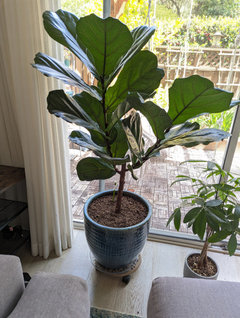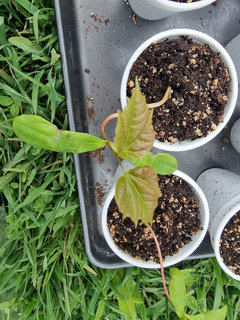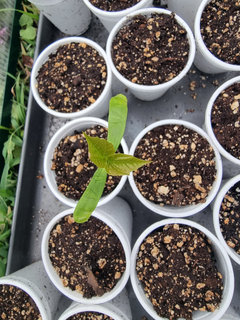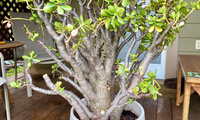Recent Activity

LOL
IDK if DE kills ants, but it's worth a shot. It works on soft bodied insects, but IDK if ant bodies are soft. If the ants are living in the pot, it sounds like the soil might've become hard and hydrophobic. Ants do not want to live in a wet place. In other words, when you water, the soil is repelling the water because the soil is too hard and dry. I'd suggest you soak the plant, pot and all, in a bucket of water until the soil is completely saturated with water. You'll know if it's saturated simply by lifting the pot to see how heavy it is. Also, I'd check the leaves for any clear, sticky residue. If the plant has scale, they exude sticky stuff as they feed, which in turn attracts ants.
Deanna

Diatomaceous earth (DE) is the siliceous fossilized remains of tiny aquatic organisms called diatoms. Food grade (amorphous) DE is not toxic and we've all swallowed quite a bit of it in toothpaste and foods. It is not poisonous, rather, it works mechanically. If you envision what finely pulverized glass would be like, you have a good idea re what DE is. It's primarily silica and very glass-like. It is effective at eliminating a wide variety of household and plant pests, including ants. It works by sticking to the natural fats, oils/ wax in the exoskeleton of pests. It absorbs the fat/ oil/ wax, which causes dehydration. The process is further hastened by the product's abrasiveness.
It's efficacy depends almost entirely in how well it sticks to the target pests, so different species of ants will be more or less susceptible to the effects of the product. The food grade product is relatively safe and is often ingested to combat constipation and high cholesterol. Use ONLY food grade product as other DE products (crystalline silicon dioxide) can accumulate in lymph nodes and cause lung issues (silicosis) and other serious irritations of tissues.

All plants like water when they need it, but won't when they don't; and, even plants that live in riparian settings cannot tolerate the cycle from too dry to too wet or from just the right amount of water to too much water. IOW excess water in the pot of virtually any plant grown in a container is courting loss of viability from a fungal infection by any of the several fungi gathered under the umbrella of 'damping off diseases'.
I notice the pot appears to be resting directly on the carpet, which begs the question, does it have a drain hole/ drain holes through the pot's bottom? If 'no', look there first for whatever ailment you might suspect. You don't mention what signs the plant presents that cause your concern. What you see in a hands-on setting doesn't necessarily we will catch a problem via an uploaded image. If you describe just exactly what your concerns are, if help us winnow away what it's not, which usually leads to a more considered and accurate diagnosis.
Do check the roots. You'll be looking for 2 things. 1) If the pot really is large enough, the soil will readily fall away from the roots when you lift it from the pot. If the pot is too small, the soil/root mass will come out of the pot as a single mass. When your plant gets to that point, root congestion is already limiting your plant's growth rate and vitality level and needs to be addressed by potting up, or much better, performing a full repot which includes bare-rooting (to the degree possible with a monstera), root pruning, and a change of soil. 2) Smell the roots. They should smell earthly, like the smell of a shovel full of moist garden soil. If they smell sour, especially if their odor is slightly to significantly like rotten eggs (hydrogen sulfide) suspect root rot.
What have you been doing about fertilizing? With what? when last? Include the product's NPK %s please.
We still need to know what your concerns are. Slow or no growth? Plant's color? Evidence of insect herbivory? Suspected disease? What are the symptoms that have caused the alarm?
Al

If you're allowing the plant's pot to sit in water that collects in the cache pot, that is a serious issue. It's best to empty the cache pot after watering or water at the sink and return the pot to its cache pot only after it has stopped draining. BTW, you can reduce the amount of excess water your planting can hold by tipping the pot at a 45* angle after every watering (at the sink).
Regular nutritional supplementation is an essential part of the care regimen for almost all plants grown in pots, monstera among them. An excellent choice for plants is Foliage-Pro 9-3-6. It contains all nutrients essential to normal growth at nutrient ratios preferred by the average plant. It boasts many other attributes as well, among them the fact that it is a complete nutritional supplementation from a single source. It is definitely one product that lives up to what it says in advertisements.
If your plant is not reaching it's full genetic potential, simply staking it is not going to make it healthier or restore it to a more vibrant state. This short piece about Good Growing Practices should be helpful. It will help you avoid nearly all the pitfalls we all encounter at some point along the journey to a green thumb.
Al

bare-rooting (to the degree possible with a monstera)
@tapla (mid-Michigan, USDA z5b-6a), a curiosity of mine (I don't have a monstera): why is bare-rooting more complicated with monstera?

Here what it looks like 7 months later - saving succeeded :)


Good job - mission accomplished. If you want your plant to become much fuller, cut back the branches to 2 or 3 leaves a bit before the summer solstice. This will force new lateral branching from nodes immediately proximal to the pruning cut. Refer to the first image I posted to your thread. Good luck!
Al



Here's a photo.

Actually seems very comparable to the coarse perlite in the link Al posted. This was a scoop from the top part of the bag. As you go down, just like potato chips, you get smaller chunks and some dust. Is it the usual amount? No idea as I don't have much experience buying perlite. Which is why I posted to get feedback on others experience.
As for price, $40 something for a 4 cu ft bag seems about average, with the exceptional price @Atheen - 7a - in Maryland, USA was able to get on sale. Nice find!

I'd say check your local Hydro store.That PVP stuff is not consisent and more dust than #4 or #3 grade . I've used one bag of that. I suppose it depends on how it's handled but IME, if you can visually see a bag (like buying it locally at the local Hydro store), easier to see how consisten the entire 4Cu bag is

tapla, as I asked rhizo, above, do you have links to the info you using? I'm not trying to turn this topic into a botany course, but I am personally interested in how plants do what they do. There's a Ph.d plant person out of Oregon who spews a lot of stuff, and some of her "evidence" is the total absence of scientific studies. She must think that the absence of science is science.
The shampoo I use for the garden does not have SLS or SLS, but modern chemistry marketing has a way of creating new names for old products to keep folks like us from staying current.
What is better about potassium based surfactants? As I recall shampoos used to have potassium based surfactants.
Dish soaps usually have antibacterial ingredients, so I would typically not suggest using those in the garden. Shampoos don't use that term.
Regarding your second paragraph (the meat of your post), I would suggest that different plants would have different levels of response to the surfactant used. Some waxy cuticles might wash away easily and some might be impenetrable with simple surfactants. Some may regenerate their cuticle quickly and some may take more time. The idea of the surfactant is to hurt the spider mites enough that they move on or die but not hurt the plant enough to damage it. The purpose of the molasses is to improve the health of the plant exterior, ideally making the plant "invisible," or not interesting, to spider mites.

"What is better about potassium based surfactants?" I already noted that soaps based on long-chain fatty acids of potassium which are formulated for their insecticidal properties are specifically designed to be easier on plants, but even these products can be harmful to cuticular waxes in some plants.
"I would suggest that different plants would have different levels of response to the surfactant used." That is possible, but has no bearing on the fact that most household products like shampoo and dishsoap have a number of phytotoxic ingredients. I have no problem if you use them as you wish. I'm just putting the information out there so others know there are far better strategies.
"Some waxy cuticles might wash away easily and some might be impenetrable with simple surfactants." Wishful thinking.
"Some may regenerate their cuticle quickly and some may take more time." That's a lot of 'suggesting', 'mights', and 'mays', which suggests you don't really understand how some surfactants and detergents affect the leaf cuticle. I might suggest that apples will start rising from the tree tomorrow instead of falling to the ground, but I think we'd both agree the suggestion doesn't merit equal time in a physics classroom. The fact is, most detergents, surfactants, and most of the ingredients used in their formulation are harmful to plants - to the cuticle and particularly to the root's lipid membrane should the surfactants make way into the soil.
"The idea of the surfactant is to hurt the spider mites enough that they move on or die but not hurt the plant enough to damage it." Wouldn't it be better to use insecticidal soap or a 2:1 or 1:1 solution of water and 70% unscented isopropyl (rubbing) alcohol? Both offer instant knockdown when applied and will easily keep might populations under control when applied by spraying/spritzing at 4 day intervals.
"The purpose of the molasses is to improve the health of the plant exterior, ideally making the plant "invisible," or not interesting, to spider mites." How can molasses make the "plant's exterior healthier"? I wouldn't use molasses on a plant anymore than I would use a solution of sugar or corn syrup and water. The reasons are several - sticky mess that attracts insects and clogs/inhibits pores that facilitate gas exchange (stomata/ lenticels) in plants. Collects dust on foliage and supports growth of sooty mold, both of which inhibits photosynthesis.
Al

Thanks so much Tapla!
I really appreciate the pictures, thank you for sharing!
Wow, I guess they really are very slow growing trees. I had considered growing it from seed but I'll try to get a decent sized seedling instead.
Good to know the foliage fragrance is not all that, I'm not really surprised; vendors often exaggerate plant fragrance claims.
I've never grown caudex plants, but they do seem like a good option in my hot and mostly rainless climate. I'll look into the Gerrardanthus, I like the overall look of that one a lot .
Thanks again for your insight!

Oh no, poor palm! But don't worry, it's not a goner. Just trim the rough edges of the gash with clean scissors to prevent infection, and let it dry out to form a natural seal. Keep it in stable conditions—enough light and not too much water. It should heal up fine with some TLC!

Trimming the edges of a wound with a crushing tool like scissors/ secateurs is not a good strategy. While it's true that cleaning up the edges of a wound with an extremely sharp cutting tool like a single edge razor blade/ utility knife blade or a scalpel hastens "healing", tools like scissors and secateurs crush delicate cambial tissues, which increases the probability of fungal/ rot issues and is likely to increase the size of the wound and the time it takes the wound to heal.
Also, allowing the wound to dry out is very counterproductive as it ENSURES desiccation of viable tissue surrounding the wound, which also increases the size of the would and the length of time it will take for the wound to close.
Al

just wanted to know if this tree is picky about being moved, like some.. thanks

Transplanting should occur at or before the first hint of budswell for spring planting. In fall, transplant after leaves are killed by frost/freeze and protect new roots from freezing. If you don't have a strategy for protecting new roots, wait until spring.
Al

Some maples need a period of cold stratification to release the seed from its dormant state, others (like A saccharinum) will germinate as soon as collected w/o any stratification. Putting a seed that doesn't require stratification through the process usually causes rot or poor germination %s.
If you know your tree's species, and it's listed at Schumacher's site, you should be able to determine what stratification process, if any, is required.
See Schumacher's here.
Al

They do look a bit leggy.
Increasing sun exposure is good but if it's still too cool outside, they may stop growing or even go dormant.

Their Maple leafs are starting to sprout now. 😊



We've had several threads about Magnolia scale. The complaint includes production of honeydew which attracts undesirable insects and sooty mold is also a problem. The same problem occurs with an explosion in aphid populations. "spraying sugar water" on foliage is a really bad idea.

The product of photosynthesis is glucose, which is a monosaccharide. The sugar we purchase in a bag is a polysaccharide, a more complex sugar that plants can't easily absorb or break down. Since anything in the soil solution that adds to the EC/TDS (electrical conductivity and total dissolved solids) of the soil solution can limit uptake of water and nutrients which are essential to normal growth, adding it to the soil solution is not a good strategy.
Sugar-water sprayed on foliage can clog stomata (openings in leaves which are regulated [opening/closing] by the plant) and the millions of intracellular pores in the leaf cuticle (skin). This would limit CO2 intake (limits photosynthesizing ability) and oxygen's escape from leaf tissues. The result would be less sugar (plant's energy source) available for metabolic processes and growth.

Last year I found an adorable bird nest intdeep in the center if my GIANT Boston Fern on my deck. I never knew it was there! When the season was ovet I removed it.This year they are in the center of my GIANT hanging spider plant. They are ”house finches”. Just watch them bring their materials and know what they are doing. I water very gently & it works out fine. What a pleasure & privlege!!

The question comes up often. I have asked that question several times of people in the horticultural field and have always received a reply that essentially said, "I don't know". In summer, I tend to water during the hottest part of the day, and I water straight from the hose. Only a very few woody plants are in shade, the rest are in full sun all summer. My opinion is, it's beneficial because it cools the soil and increases evaporative cooling.
Watering with ice cubes is a growing craze that seems to have a number of people speaking out against it; yet, all I've heard is that "it shocks the roots". While I wouldn't use ice cubes to water (for a number of reasons), I think I would want to actually understand what, if anything, a sudden flood of cold water actually does to plants physiologically, and how does one determine 'how cold is too cold' and does it vary by plant and/or the current root/soil temp at the point in time when the plant is watered.
If you find anything you think is reliable, please post so we can evaluate and potentially share with others when the question arises.
Al

Hi @ShadyWillowFarm
I'm not sure what system you have, but it sounds like a R/O filter rather than a softener. I'm glad it's working for you.
However, water softeners do not correct pH and they do exchange sodium ions for calcium and magnesium ions. So, if the untreated water is very hard, the softened water will contain much more sodium. And that sodium can build up in the soil over time with indoor plants. How much is too much for plants depends on the plants, and the hardness of the untreated water, how much watering is done, etc.
Again, I appreciate that what you have is working for you - but I don't think it's a water softener.

From the NIH:
"Softened well water in our area on average contained a 2.5-times-higher concentration of sodium than local municipal water, comparable with previous reports. It is unlikely that the increased sodium from softened water would have any health risks for most people. This may not be true for people on severely sodium-restricted diets."
You learn something every day.

You can very easily prune your plant so it has a single trunk with virtually no concern that the pruning will cause the plant life threatening harm.
The trick to pruning jades and portulacaria is to leave a very short stub. You don't want to cut into the node on the trunkline that gave rise to the branches you're viewing as subordinate, or competing trunks. When you leave a short stub, sealing the wound is unnecessary because the wound will dry back to the first node proximal (closer to the roots or trunk) to the cut. Once the pruning is done, in 6 months to a year you'll be able to simply rub off the desiccated tissue with your thumb, making it difficult to tell it was even pruned. Cutting flush to the lower order branch (the branch the you're pruning is attached) or trunk will cause tissue to dry out in the immediate vicinity of the wound, such that the wound will be larger, deeper, more unsightly, and it will take longer for callus tissue to cover the wound.
I would advise that you carefully cover the existing wounds with waterproof wood clue, which will prevent the wounds from growing larger due to desiccation. Use a flat toothpick or similar item to carefully paint the wound only. Try not to overlap the wound and get glue on the periderm (bark); this, because it will make a lump when the callus rolls over the glue.
Al

@ken_adrian Adrian MI cold Z5 generally speaking, when jade plants are getting the appropriate amount of light, their leaves will turn more of a light green or gold. Jades with dark green leaves are usually either being overfertilized or aren't receiving an appropriate amount/intensity of light, or both. However, there are different cultivars of jade which have slightly different leaves, so it's difficult to know for sure without knowing the specifics of which jade it is. Most jade plants that I see posted on plants forums or groups are very etiolated, but that one isn't, so for its first 20 years it received appropriate light. Can't say if it currently is since they grow very slowly and it likely hasn't had time to respond to its current light situation. Seems like many people place them where "they'll look good in the room" rather than where they'll receive the light that they need.
Deanna

Thanks for info, Al.
I confess I have sometimes let 5:1:1 and Gritty mix have a baby. Most often is changing pots and re-using soil mixtures that aren’t broken down much, so the bark fines, which are often Reptibark, so not cheap, are still good , and I’m not always running properly labeled bins of used soils ( “ used 5:1:1”, “ used unknown potting soil”, etc). Or, a pot has just been drying out too much as pure gritty.
Hope it’s not too heretical but seems like containers at least have better drainage and is practical for getting things done , and better than what I used to use!

Just because you mixed the 5:1:1 and gritty mix together doesn't mean you did anything 'wrong' or shot yourself in the foot. What it all boils down to is this: If you want to mix the gritty mix together with 5:1:1 you will introduce a perched water table, which the gritty mix is designed to eliminate entirely or almost entirely. You will have a medium roughly equivalent to the 5:1:1 mix in terms of usability and productivity, perhaps slightly but not conspicuously better than the 5:1:1, but not as good as the gritty mix in terms of drainage and air porosity. Still, you'll have a much better medium than you'd be likely find in bags or bales of media based on a high % of fine materials (peat, coir, compost, composted forest products, .....) .
I'm not here to talk anyone into anything; rather, I try to provide reliable and straight forward information that can help others make an informed decision. I look at that as an extension of my own growing experience, and getting all wound up about what someone chooses to do would diminish my enjoyment. If someone disagrees with something I put forward and I think what was said has the potential to diminish readers growing experience (because it's inaccurate or biased) I'll support my position, not because I care all that much about what they think. It's not because I want someone to 'do as I say', rather, it's because I wouldn't want info offered in error to lead you down a path that limits your enjoyment or potential for success/ best results.
When we lack the information to make the best decisions, we usually don't (make the best decisions); however, when we are well informed we still might make a compromise due to how our priorities are ordered, but at least we understand we're making a compromise and how to fix it next time if that doesn't work out. That's how I look at things. YMMV
Hope you're having a good weekend. I'm repotting like a maniac. It's supposed to be quite warm for the next 12 days, once we get beyond tonight's freezing temps. Starting tomo, I wont need to bring my temperate plants, now on carts, in and out of cover overnight. Below is about 1/3 of the temperate plants.


Al








What is your concern? The plant is Ficus elastica 'Tineke'. If you can rely on the meter for an accurate pH level, 7.0 is about the upper limit. 6.0-6.5 would be more desirable and can be achieved by using an acid-forming fertilizer like Foliage-Pro 9-3-6, which is very likely the best choice you could make.
Fertility and watering practices are inextricably intertwined. Ideally, you would water thoroughly each time you water, completely saturating the entire soil column, using enough water that at least 20% of the total volume of water used exits the drain hole. This type of watering ensures minimal build-up of dissolved solids (salts) in the soil and that the actual ratio of nutrients in the soil does not become badly skewed over time. You'll do better if you skip the water meter and use a tell made from a 1/4-5/16" wooden dowel rod. Insert it in the soil all the way to the pot's bottom and water only when the soil is nearly dry.
Tying your fertilizer applications to the number of times you have watered makes more sense than arbitrarily using the calendar as your guide. Fertilizing about every 4th or 5th watering during the dark months, and every 3rd or 4th watering during the long days of late spring - early fall is a good plan.
Your plant wants very bright light, 4,000 - 8,000fc. Light diminishes by the square of the distance from the light source. What this essentially means is, a plant 5 ft from a window gets only 1/25 the amount of light it would receive if 1 ft from a window. I have many species of ficus and all are grown in full outdoor sun in summer.
This is just general info. We would need to know what has you concerned in order to address the issue directly. Plants grow when they make more energy during photosynthesis than they burn during respiration. If your plant is not growing, it means the plant is using all it's current energy production, to keep it's systems orderly. Plants in this state are especially susceptible to insect herbivory and disease pathogens.
Typically, if low light is not the limiting factor, it will be inappropriate nutrition or a root problem, like soil compaction, root congestion, or a fungal root infection, but as of yet, there isn't enough information to reach a conclusion re root issues.
This link to Care of Ficus Trees in Containers might be helpful.
Al
What exactly is troubling you? I can't see anything wrong with the plant considering it is still quite a young cutting.